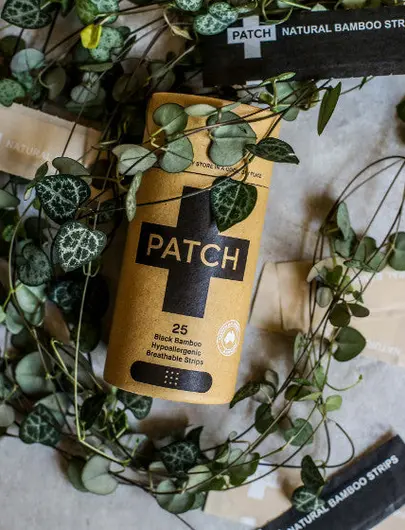If you’ve been reading the GoodnessMe blog for some time now, you’ll know that our criteria – “Food with integrity” – is something we don’t only apply to food products, but to beauty and skincare products too, all the way through to plasters! (And let’s be honest, we tend to go through quite a few of them with all the zoodles we make and carrots we grate in the kitchen!)
If you're one of those people who seem to end up grating their finger every time they're in the kitchen...read on!
Next time you fall victim to the veggie spiraliser, try PATCH! These biodegradable adhesive bandages are the brainchild of the brand’s founder James, who noticed his adventurous little boy’s skin was reacting badly to the chemical adhesives in common plasters.
While James couldn’t stop his little one from adventuring and the inevitable bumps, bruises and grazes that came with it, he thought that he could do something about the plaster situation.
What started as a tissue and elastic band wrapped around a big toe (not fun when your little one wants to play some footy!) evolved into PATCH: hypoallergenic adhesive strips that look just like a regular bandaid, but without all the funny chemical ingredients that we’ve never heard of and can’t pronounce.
What’s lurking in our plasters?
Even plasters can be loaded with nasties. Commercial plasters tend to contain:
Thimerosal and Merthiolates
Say what? We prefer to stick to ingredients we recognise. Thimerosal and merthiolates are both lab-produced, mercury-based preservatives with antiseptic properties.
You won’t find these in PATCH, which has added natural goodness from activated charcoal, aloe vera and coconut oil – these help to soothe the skin and promote wound recovery…no red marks left behind.
Latex
This can actually be found in nature, with latex being the milky fluid derived from Hevea brasiliensis, AKA the rubber tree! During manufacturing, a number of chemicals (such as thiurams and carbamates) are added to latex-containing products like plasters, in order to make them more elastic and durable.
The problem with latex? It can be an allergen, with some individuals experiencing allergic contact dermatitis upon applying something like a plaster to their skin. Symptoms might include a dry rash that is rough and scaly, with weeping sores in some cases. Symptom-onset usually takes place 12-48 hours after the skin has come in contact with latex. Because other chemicals are added to latex-containing products during manufacturing, it can be difficult to know whether the reaction has been caused by the chemicals, or the latex itself.
Latex can cause irritant dermatitis in others, which is not an allergy as such, but more of a skin sensitivity (like a food intolerance). While irritant dermatitis symptoms are similar to those of allergic contact dermatitis, the immune system is not involved, and it is caused due to the skin’s sensitivity.
If you're looking for natural bandages to add to your first aid kit, try PATCH! You can find a plethora of other natural items to add at GoodnessMe.

